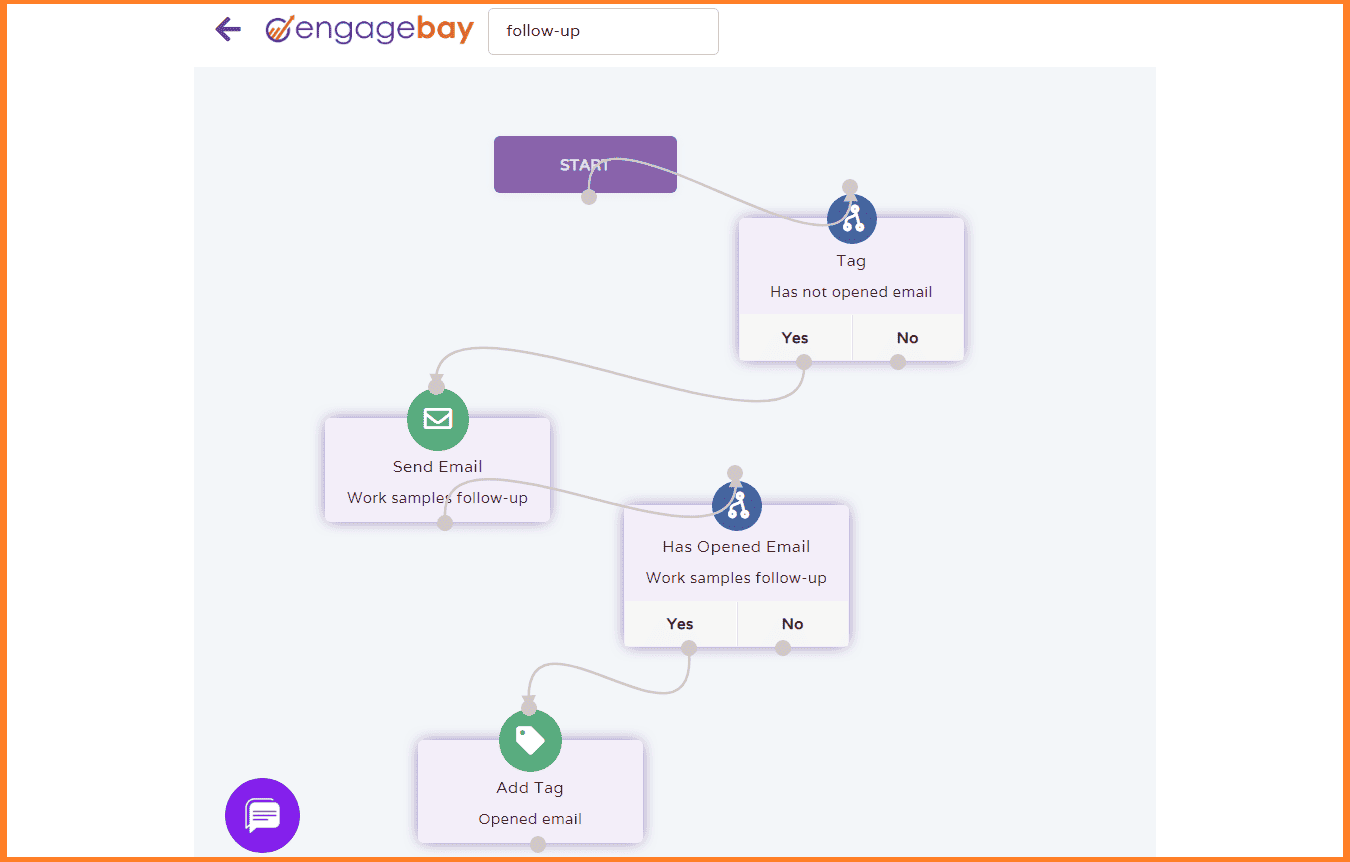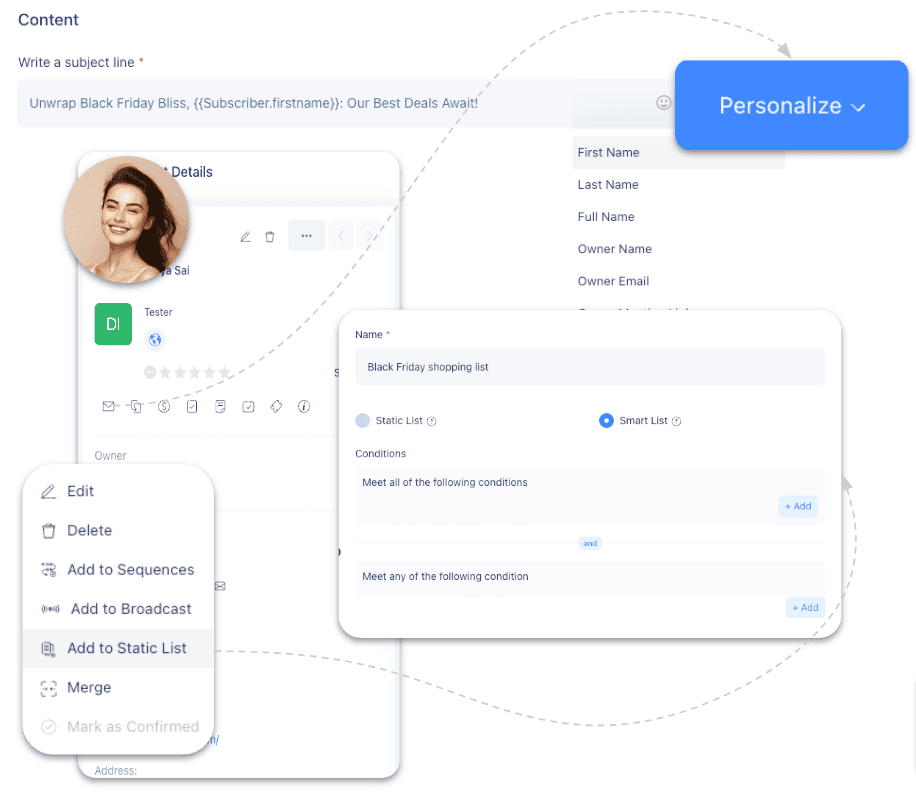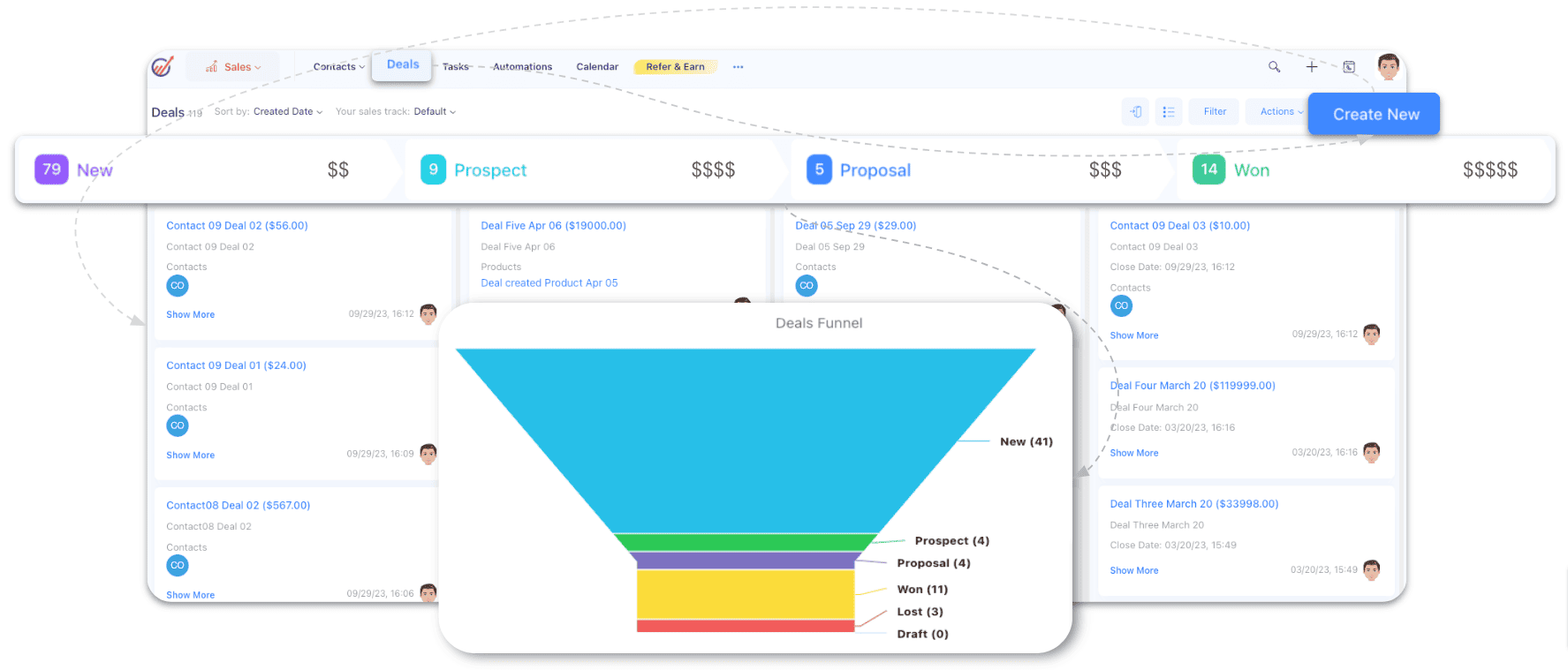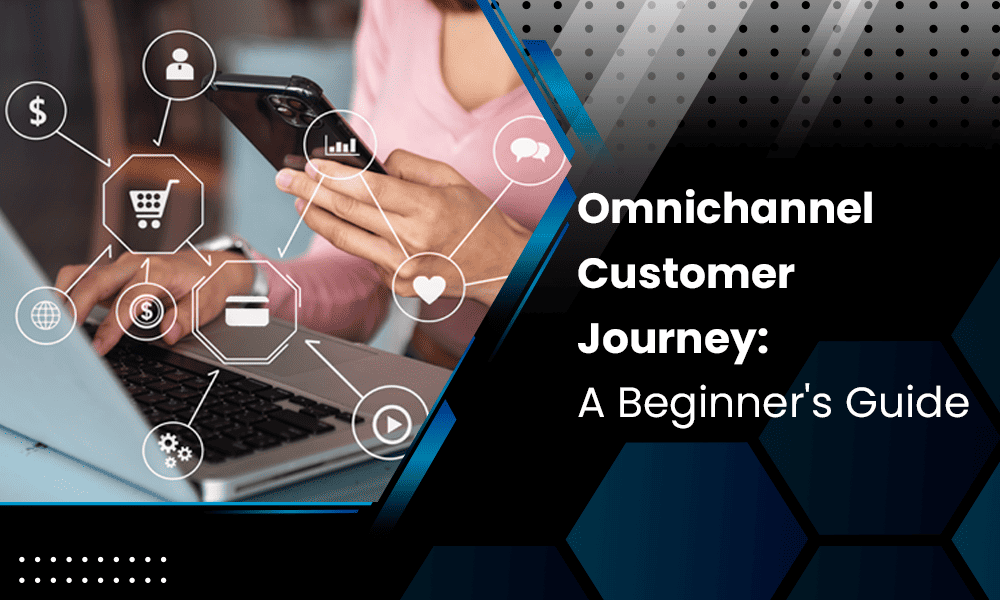As the bounds of technology grow, and with them, our abilities to communicate and interact on different levels, businesses must be willing to go above and beyond to meet customers at varying touchpoints.
Omnichannel marketing is how today’s companies respond to this growing consumer demand. However, launching an omnichannel campaign doesn’t guarantee its success. You must understand the customer journey to build an omnichannel roadmap.
This needn’t require trial and error that can put the customer experience at risk, but rather, a clear and concise journey to follow.
This guide to creating a customer journey map will cement your understanding of the importance of omnichannel marketing and what components your omnichannel strategy needs so you can better connect with your audience.
Table of Contents
What Is an Omnichannel Customer Journey?
The omnichannel customer journey refers to the journey a customer takes across several channels while engaging with a business. In this age of digital marketing, this often includes several touchpoints or communication channels. Customers will discover your company through one touchpoint, such as an ad that redirects them to your website.
Once on your website, the customer’s journey may expand to other communication channels such as SMS messaging, email, blog, the company’s YouTube channel (if any), and social media.
However, a customer journey isn’t merely mapping out the touchpoints a lead uses until conversion and beyond. It’s determining which of those communication channels they most prefer and meeting them on those platforms.
That’s the key to connecting with customers and keeping them engaged: communicating on their preferred channels.
There should exist no disconnect between one platform or communication channel and another. The basis of omnichannel marketing is mastering the seamlessness of interaction, whether your customers are old school and prefer just a few touchpoints or are chronically online and use every touchpoint imaginable.
The omnichannel customer journey should guide leads through the research and shopping phase until they buy and convert, then through the service stage and beyond.
The Components of an Omnichannel Customer Journey

The touchpoints mentioned above are several you can use as you plan a more immersive customer experience. The following omnichannel customer journey touchpoints must also be included.
One of the most popular channels for reaching customers, and arguably the biggest, is email. The personalization potential is high, making email a viable strategy for connecting with your audience.
You can segment your audience to determine who sees which messaging and when, incorporate the recipient’s name into the subject line or body copy, and send tailored messages for their birthday or other special occasion.
Marketing resource HubSpot reports that four billion email users check their inboxes daily. That number has steadily increased over the years and should continue its upward trajectory. Email is not poised to become any less important, so prioritize it as a main touchpoint.
Social Media
Another can’t-miss communication channel to include in your omnichannel customer journey is social media. Forbes reports that 4.9 billion people use social media globally in 2023, making this another touchpoint you must prioritize as you begin mapping your customer journey.
Since the basis of omnichannel marketing is connecting with your audience on their platforms, you must research the social platforms they gravitate toward the most. Whether they like Facebook, LinkedIn, Twitter, Instagram, or YouTube, they strive to build a solid business presence on each.
Engaging with your audience on social media entails doing more than cross-posting blog or website content. You must post high-value, engaging content that interests your audience and gives them a reason to add you to their feed. That can include your own content and reputable third-party posts.
Website
Your website is another pillar of omnichannel marketing. As mentioned, your site might be the first touchpoint your audience finds you. Since it kickstarts the customer journey, your website must be optimized for navigability.
Use split testing to determine which of your elements are the most appealing and which placement to prioritize. Put your CTA buttons above the fold, use whitespace effectively, and keep your navigation bar easy to use. Consider adding a search bar to the navigation or having it travel with users as they scroll down the page.
Incorporate your company colors into your design, but choose complimentary hues that don’t clash or hurt the eyes. Ensure your website is mobile-optimized, as more than half of your website traffic will come from a mobile device, reports Exploding Topics.
Microsites and Landing Pages
Landing pages are one of the most important components of your website. These pages are dedicated to a product or service. You should have landing pages for each product or service your company sells, whether that’s 10 or 100.
A landing page is often linked to an ad. Let’s say an internet user clicks an ad for your vacuum cleaner. The ad would redirect them to a landing page for the vacuum. It would be misleading if an ad for a vacuum cleaner took the lead to a landing page for a hairdryer.
Some businesses have expanded upon landing pages, creating microsites. These web page clusters provide more information on a product and service, utilizing its own subdomain or domain.
A microsite might allow a customer to check out without clicking off the site, expediting the shopping process and encouraging more sales.
Mobile apps
Your omnichannel customer journey may include a mobile app if it suits your business industry or niche.
Retailers frequently use apps. The app allows the lead or customer to shop for new items or services, check out, track their order, apply coupons, and do all the other tasks they could achieve on your website.
However, there’s no need to visit your website to shop, which is convenient and efficient. You might periodically reward app users with exclusive discounts or free shipping offers.
If you decide to use a mobile app as part of your omnichannel customer journey, take the time to design the app well. A buggy, glitchy app will hurt your company more than not having an app in the first place.
Digital ads
The next component of the omnichannel experience is digital advertising. We spoke of ads generally above, so let’s get more specific now.
Your company can select from the following types of digital ads:
- Remarketing
- Video advertising
- Mobile advertising
- Audio advertising
- Social media advertising
- Native ads
- Display ads
- Paid search advertising, such as pay-per-click or PPC ads
You will likely embrace several ad styles as you broaden your communication channels. The more types of ads you can incorporate into your campaign, the more complete your list of touchpoints will be.
However, you must temper your enthusiasm for digital advertising with a realistic monthly budget that doesn’t leave your company in the red.
Direct mail
Although a less popular omnichannel option, your business can’t afford to disqualify direct mail. Older consumers are used to receiving catalogs, pamphlets, and flyers in their mailboxes. Younger consumers appreciate the unique approach.
Since direct mail comprises a small portion of your omnichannel customer journey, you don’t need a substantial budget.
Mobile messaging
SMS marketing or mobile messaging is an increasingly significant part of your omnichannel customer experience. According to SimpleTexting, 42 percent of digital marketers and business owners used SMS marketing in 2021. That number had increased to 55 percent in 2022.
Mobile messaging is inexpensive and efficient, allowing you to reach an audience that always has their phones by their sides.
Call center
Your company must have a dedicated customer service staff ready to respond to customer questions, demands, and complaints. You should have a customer service phone number, email address, and chat feature.
You can use chatbots to engage with your leads and customers when your staff has gone home for the day. AI has made chatbots smarter than ever, capable of quickly answering customer queries and closing more customer tickets.
In-Store signage
Brick-and-mortar stores are anything but dead. More consumers would rather shop in a store than online, reports Pricespider, so it would behoove your business to dedicate some of your omnichannel budgets toward elevating the brick-and-mortar experience.
In-store signage is one option, and in-store displays are another.
Read also: Understanding Customer Journeys in Marketing Automation
How To Create an Efficient Omnichannel Customer Journey in 7 Steps
Are you ready to build your omnichannel customer journey? Here are the required steps to help you reach your customers on more touchpoints that matter.
1. Create buyer personas
You must know your target audience thoroughly before launching your omnichannel campaign. Dig deep into their demographics, geographics, and psychographics to learn about their motivations, opinions, interests, and pain points.
Once you have this information, you can use it to put together buyer personas or avatars. A buyer persona amalgamates the most recurring traits in your audience groups, making it easier for marketers and salespeople to reach those target markets.
2. Determine your strategy
After creating customer avatars, your next step is to decide what your omnichannel strategy will look like. This is when you will narrow the platforms and touchpoints you will use to communicate with your audience based on their preferences.
3. Build the customer journey map
With the pieces of the puzzle coming into place, you can now assemble the parts of your customer journey as a map to use for future campaigns. The customer journey generally breaks down into four stages, with appropriate touch points varying for each.

The first stage is awareness. An internet user finds your website or social media page through an ad, a search engine results page, or a referral from a friend, family member, or colleague.
The touchpoints at this stage are designed for exploration and discovery. Leads might find you accidentally, but if you’re targeting the right audience segments on their preferred platforms, more leads should discover your brand intentionally.
The second stage is consideration. By this point, the lead should have migrated to your website if they didn’t already begin there. They’ve learned about your company and your products and services. However, they have yet to make up their mind.
They’re still comparing their options, researching pricing, and considering their needs.
During the consideration stage, the most important touchpoints are your website, email newsletter, and phone calls.
The third of the three phases is decision. The lead has gathered enough information and is ready to make their choice. They might request a tour, trial, or demo before they reach this phase. Then, they’ll be ready to sign up.
The last stage is delight or usage. You will continue utilizing the above touchpoints to communicate with your newly converted customer and ensure their satisfaction. You will also introduce referrals as a touchpoint in this phase.
Read also: Master Your Outbound Marketing Strategy for B2B Success
4. Use the right tools
Software tools will make implementing and tracking the customer journey a more doable process. Here are some tools to add to your sales and marketing stack.
- Customer relationship management software: A CRM will log all lead and customer data as it accumulates, building a shareable record. Sales reps and marketers can add notes, email records, phone transcripts, and other data for a 360-degree customer view.
- Marketing automation software: Automating campaign elements like social media posting, email drip campaigns, and SMS marketing saves time so you can juggle all the platforms and channels you’re using to reach your audience. However, you must remember to fine-tune the marketing automation workflows throughout the life of your campaign to ensure they’re efficient.
- Email marketing tool: An email marketing software will help you knock it out of the park, sending five-star emails with high open and click-through rates. You can browse appealing, responsive email templates or create your own using drag-and-drop builders. Email marketing tools include email sending, deliverability features, and email campaign analytics.
- Chatbots: You’ll recall that chatbots are a great aid for your customer service team. Chatbot technology has only gotten smarter thanks to AI innovations, enabling the bots to work like another customer service team member. Your reps will only get the most complex inquiries a chatbot can’t handle alone.
- Analytics and reporting: Your omnichannel marketing tools must have a reporting component with full analytics for gauging the success of your campaign and what to improve.
EngageBay is an all-in-one marketing, sales, and service tool with the above features in its software.
You can understand more about your audience than ever before with our free CRM, use automation to save time, create comprehensive email marketing campaigns, utilize chatbots, and review your campaign stats from beginning to end.
5. Review and implement feedback
You will also receive audience feedback as you expand your communication touchpoints. Track this feedback, listening for the most commonly repeating themes, good and bad.
Double down on what your audience appreciates the most about your omnichannel approach and reconsider the strategies that haven’t accumulated as much success. Perhaps retool them before abandoning them altogether, giving your campaign more time to play out before changing tact.
Consider that feedback will change as your customer needs do. Your omnichannel customer journey should seek to understand your audience better, but that doesn’t mean all their needs or challenges will disappear.
Rather, your deeper level of understanding might reveal new challenges to tackle.
6. Find all the gaps
The omnichannel customer experience shouldn’t have any gaps, so analyzing your seamlessness of yours is a must. A more fragmented experience will make it harder for you to reach customers and could introduce more areas for you to lose prospects before they successfully convert.
Gap analyses can reduce these instances, ensuring you’ve fortified the omnichannel experience from beginning to end.
7. Master analytics
The customer journey analytics you will accumulate can be fed to your CRM from offline and online channels, allowing you to connect all your touchpoints and extrapolate data from each.

You will focus on myriad metrics, but three metrics worth paying the most attention to are the Customer Effort Score, Customer Satisfaction Score, and Net Promoter Score.
A Customer Effort Score or CES indicates how much effort it takes for your customer to get a request fulfilled, a question answered, or a complaint resolved. CES is measured on a scale of 1 to 5 or 1 to 7. The lower the number, the better.
A Customer Satisfaction Score or CSAT tells you how happy your audience is with your products or services. You can ask them to rate their satisfaction on a percentage between zero and 100 percent. In this case, you want a higher number.
The Net Promoter Score or NPS is another single-system metric. Ask your audience how much they’d recommend your products and services on a scale of 1 to 10. Those who answer 1 to 6 are detractors who hurt your business, as they have negative opinions of your products and services.
The customers who rank 7 to 8 are neutral or passive. They require more conditioning and engagement to support your business, but they could slide into detractor territory without it.
Those who score your products and services 9 to 10 are supporters. These are your most loyal customers. You should learn what makes these customers so passionate about your business so you can create a method for pushing passives up the NPS scale and reducing detractors.
Read also: 11 Affordable, Powerful Customer Journey Mapping Tools
The Benefits of the Omnichannel Experience
Although omnichannel customer journey mapping can be a bit time-consuming and expensive, it pays back dividends to businesses willing to stick with it. Here are some of the greatest advantages of omnichannel marketing.
A better understanding of your audience
Learning about the touchpoints your audience prefers isn’t merely so you can sell them products or services. You learn helpful psychographics that will affect how and where you communicate with your audience going forward.
Your customers will feel better understood, fostering a stronger business relationship you can’t achieve when you only guess which touchpoints to use.
More personalized product and service recommendations
Thanks to omnichannel marketing, the communication channels you use will already feel more personalized. You can also use the customer data you generate from your campaigns to recommend products and services designed to address pain points.
The tailored product/service offerings on preferred touchpoints should increase your sales and conversions.
More customer loyalty
The sales shouldn’t occur only once but recurringly over the lifetime of your customer’s time in the sales funnel. As your customers build their loyalty, they’ll not only become reliable buyers, but they’ll gladly recommend your products and services to others in their lives.
Read also: Understanding Customer Journeys in Marketing Automation: A Guide
The Challenges of Omnichannel Marketing
Omnichannel marketing is not without its difficulties. The following challenges are worth anticipating and solving.
Not enough expertise
Omnichannel marketing requires understanding many platforms and channels and then tying everything together. It’s a recently growing marketing trend, and not all companies fully understand the ins and outs.
However, omnichannel marketing will only grow in importance as the 2020s continue. If your staff lacks the knowledge and understanding of the omnichannel experience, do yourselves a favor and learn it now before it becomes a mandatory part of your marketing campaign requirements.
Misalignment on priorities
Failing to prioritize omnichannel marketing is a huge mistake. We can’t stress enough that the omnichannel experience is one customers want from all businesses. If you fail to anticipate the needs of your audience and the platforms they use to get those needs met, you risk being left behind by the competition.
You should reevaluate whatever else you put over omnichannel marketing, reorganizing your priorities.
Hard to integrate
Integrating omnichannel measures into your other systems can be challenging but worthwhile. If you must hire third-party professionals to help with the integration, even temporarily, that will be money well spent.
Budget
The digital marketing budget your company has set should account for omnichannel measures. If your budget still doesn’t give you enough room to incorporate several communication channels, limit the omnichannel touchpoints you focus on initially, broadening them as you realize campaign value.
Read also: Marketing Automation Best Practices for the Non-Technical Marketer
Bottom Line
The omnichannel customer journey helps you understand where your audience comes from and meet them at those touchpoints. This fosters a stronger connection from the start, building toward a positive professional relationship.
Your business is now ready to learn more about your customer journey and the communication channels your audience prefers.
For an all-in-one marketing automation and customer relationship management (CRM) solution with a free support desk, try EngageBay today and join a club of 46,500 happy users!

